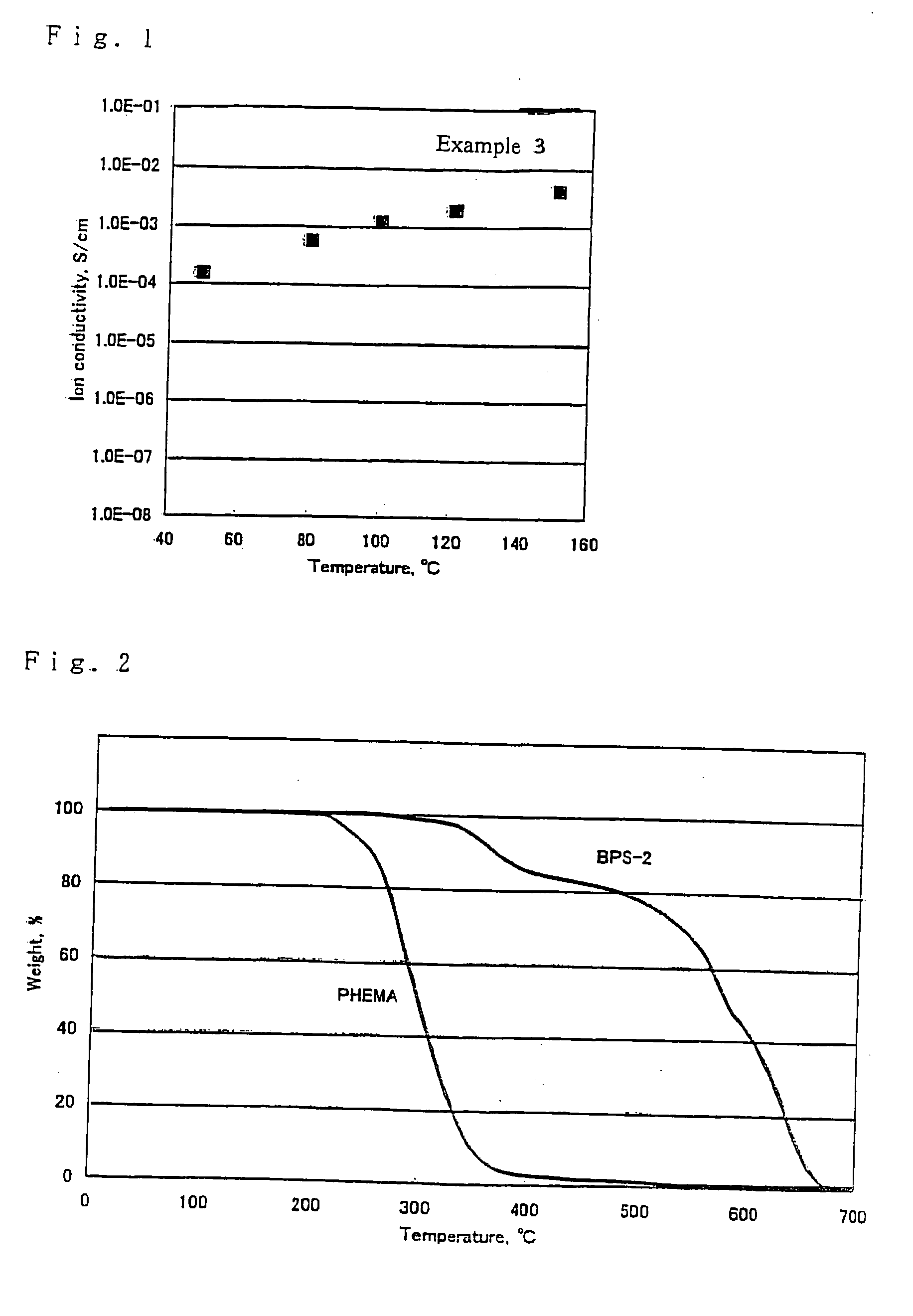Polyelectrolyte compositions
a technology of polyelectrolyte and composition, applied in the direction of conductive materials, non-aqueous electrolytes, fuel cell details, etc., can solve problems such as strength reduction, and achieve the effects of high ionic conductivity, high cost and durabl
- Summary
- Abstract
- Description
- Claims
- Application Information
AI Technical Summary
Benefits of technology
Problems solved by technology
Method used
Image
Examples
synthesis example 1
Synthesis of Sulfonic Acid Group-Containing Aromatic Polyether Sulfone Random Copolymer (RPS-1)
To a mixture of 51.4 g of bis(4-fluorophenyl) sulfone, 25 g of bis(4-hydroxyphenyl) sulfone, 18.9 g of 4,4′-biphenol, and 36 g of potassium carbonate were added 300 ml of N,N-dimethylacetamide and 200 ml of toluene, and the mixture was heated while stirring in a nitrogen stream. The temperature was elevated up to 165° C. while removing produced water together with toluene. The stirring was continued for 3 hours at that temperature. The solution was poured into a large quantity of water to precipitate a white solid, which was collected by filtration, washed twice with hot water and once with methanol, and dried under reduced pressure to give copolymer RP-1. The solution viscosity ηsp / c of the resulting polymer was 0.55.
Ten gram of copolymer RP-1 prepared above was dissolved in 100 ml of 98% sulfuric acid, and the solution was stirred at room temperature for 24 hours. The solution was po...
synthesis example 2
Synthesis of Sulfonic Acid Group-Containing Aromatic Polyether Sulfone Block Copolymer (BPS-1)
In a four-necked flask equipped with a stirrer, a water content meter, a thermometer, and a nitrogen inlet were put 51.4 g of bis(4-fluorophenyl) sulfone, 50 g of bis(4-hydroxyphenyl) sulfone, and 36 g of potassium carbonate. To the mixture were added 300 ml of N,N-dimethylacetamide and 200 ml of toluene, and the mixture was heated while stirring in a nitrogen stream. The temperature was elevated up to 165° C. while removing produced water together with toluene. The stirring was continued for 3 hours at that temperature. The solution was poured into a large quantity of water to precipitate a white solid, which was collected by filtration, washed twice with hot water and once with methanol and dried under reduced pressure to give hydrophobic segment prepolymer al. The solution viscosity ηsp / c of the resulting polymer was 0.42.
To a mixture of 25.7 g of bis(4-fluorophenyl) sulfone, 18.9 g ...
synthesis example 3
Synthesis of Sulfonic Acid Group-Containing Aromatic Polyether Sulfone Block Copolymer (BPS-2)
In a four-necked flask equipped with a stirrer, a water content meter, a thermometer, and a nitrogen inlet were put 75.5 g (0.263 mol) of bis(4-chlorophenyl) sulfone, 50 g (0.269 mol) of 4,4′-biphenol, and 48 g of potassium carbonate. To the mixture were added 400 ml of dimethyl sulfoxide and 50 ml of toluene, and the mixture was heated while stirring in a nitrogen stream. The temperature was elevated up to 180° C. while removing produced water together with toluene. The stirring was continued for 3 hours at that temperature to prepare a solution of polymer b2 (prepolymer (B)). The number of the repeating units of polymer b2, r4, was about 44 as calculated from the feed ratio.
Separately, 160.9 g of SUMIKAEXCEL 4100G (Sumitomo Chemical Co., Ltd.) having the structural unit shown below was dissolved in 480 ml of dimethyl sulfoxide to prepare a solution of a prepolymer (A). The number of t...
PUM
| Property | Measurement | Unit |
|---|---|---|
| temperature | aaaaa | aaaaa |
| temperatures | aaaaa | aaaaa |
| temperatures | aaaaa | aaaaa |
Abstract
Description
Claims
Application Information
 Login to View More
Login to View More - R&D
- Intellectual Property
- Life Sciences
- Materials
- Tech Scout
- Unparalleled Data Quality
- Higher Quality Content
- 60% Fewer Hallucinations
Browse by: Latest US Patents, China's latest patents, Technical Efficacy Thesaurus, Application Domain, Technology Topic, Popular Technical Reports.
© 2025 PatSnap. All rights reserved.Legal|Privacy policy|Modern Slavery Act Transparency Statement|Sitemap|About US| Contact US: help@patsnap.com



